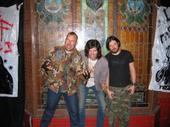Halfway through the first decade of the new century brings change to Wolf Eyes. With Aaron Dilloway relocating to Nepal, the band decided to scoop up Mike Connelly of noise kin Hair Police to pick up the slack. Connelly has been in the game since around 2000 with his own tape label Gods of Tundra and sound assault group Hair Police. He moved up to Michigan at the end of 2004 and has been jamming with Olson and Young in various projects, leading up to his introduction into Wolf Eyes. The band’s recent shows have been a return to a much more primitive and raw approach to the bands own version of Armageddon (which includes brews and Negative Approach’s “Ready to Fight†on repeat). New recordings like “Deranged†and “Droll vol. 19†highlight Wolf Eyes’ current state of mind, while new songs like “Leper War†tear it all to pieces.What someone had to say about the new record
HUMAN ANIMALThe cycle of tension and release is a well-worn musical ploy, but Michigan's Wolf Eyes have somehow managed to find new ideas in that technique's cracked façade. The band's best shows are an orgiastic symphony of hypnotic build-up and cathartic discharge. Every Wolf Eyes fan knows what to expect from the latter-- distorted, decaying beats, slashing noise from John Olson and Mike Connelly, and lung-killing rants from Nate Young-- and when to pump fists and jerk heads accordingly. The more abstract sections in between are trickier. Sometimes the trio's gnarled drift stops too abruptly, other times it out-meanders its welcome. But when these scientists hit on the right formula of slow-burning anticipation, the bombast that follows has the profundity of a drug-induced epiphany.
Previous Wolf Eyes records have struck that magic balance during individual songs or sides, but none have stretched it over an album's length like Human Animal. Here the group's pre-climactic swells seem coated with extra allure, such that the first three tracks can spend 15 minutes gradually gathering density without losing momentum. It's partially due to a patient restraint that makes the clanging "A Million Years" oddly quiet, similar to Sightings' shadowy retreat on Arrived in Gold; partially due to Olson's snake-charming sax (something he's perfected with his dirt-jazz trio Graveyards) on the war-torn "Rationed Rot"; and very much due to the way even a purely textural piece like "Lake of Roaches" throbs with insistent pulse, mimicking time's relentless march.
Whatever the reason, this dark, transfixing three-part suite makes the subsequent peak of the title track pretty staggering. "Rusted Mange" extends the climax with rhythms that overlap like competing fireworks. Mixed with more Young vocal screech and Olson sax whine, the piece splits the difference between didactic pound and inscrutable cacophony, delivering the promise of the preceding simmer.
The trio's tension-release loop gets lathered, rinsed, and repeated on Human Animal's final three tracks, this time in a quicker, sharper rotation. The six-minute "Leper War" detonates windy bombs over a smoldering static terrain, fading into the rippling march of "The Driller", whose deadened pound sprouts into a hummable lurch. As Young's moans rhyme with the surrounding din, the track actually becomes more like music than noise.
Which makes "Noise Not Music" a logical closer. Here instead of noise made from pure abstraction, we get music beaten until it shatters into noise, with what sounds like 100 simultaneous punk songs piled into endless climax. The song's chanted title may be a brutal manifesto, and Wolf Eyes' metronomic swing can sometimes be fascistically either/or. But Human Animal is far from black and white; it's more like its melted-face cover painting, a dripping swirl of different shades of gray.
-Marc Masters, September 21, 2006
